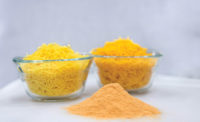Chr. Hansen’s new freeze-dried culture blends are optimized for cost-efficient production of mozzarella. “Our new culture blends are targeted specifically at giving the best possible robustness against bacteriophages, so the pasta filata dairies converting from bulk starter to the new FD-DVS STI cultures can eliminate the risk of having dead vats or downgrading of cheeses,” says Nanna Borne, marketing manager, cheese cultures, Chr. Hansen. “Naturally, we expect this to find favor with the Southern European producers of mozzarella but also South American dairies have been requesting cultures of this sort.”
The core properties of the STI culture blends make them attractive in times with intensified focus on cost:
- Exceptional phage robustness due to the presence of multiple strains in each blend. The synergy between strains mean excellent performance and no delays or scrap in production due to poor acidification.
- The anti-bacteriophage properties of the new blends make them very suitable at dairies where the cheese production process is automated in a dry matting conveyor.
- The availability of three different blends makes it possible for the cheese manufacturer to rotate and thereby minimize the risk of propagation of bacteriophages in the production environment.
- The cultures are available in various pack sizes fitted to the average vat sizes of small and mid-size dairies. This makes them convenient to use compared to bulk starter.
- The Direct Vat Set production technology offers a number of advantages in terms of flexibility of use, consistent performance, possibility of using customized culture blends and no investment in bulk starter equipment.
“The compact freeze-dried format makes it easy for the cheese manufacturer to store and handle the STI starter cultures,” Borne says. “Comparing parallel productions of cheese made with the STI blends and traditional bulk starter, the STI cultures proved faster in acidifying the cheese milk. Compared to handling bulk starter only one pouch of STI culture (< 100 grams) is needed to inoculate a tank of 5,000 liters of milk, where traditionally 5 liters of bulk starter was needed to obtain the same effect.”
Including mozzarella, pizza cheese and provolone the pasta filata segment makes up 12% of total European cheese production; 900.000 tons are produced annually. The main part of the traditional fresh mozzarella is produced at approx. 50 dairies primarily in Italy.
Abbasciano Dairy in Trento, Northern Italy is one of three Italian dairies that have trialed the new culture blends. Piero Denti, manager at Abbasciano Dairy, says: “Having tested the ‘STI’ blends I can say that they match the high quality level that we are used to from Chr. Hansen cultures. We registered no phage activity and the end-product - fresh table mozzarella - had excellent structure and delicious aroma.”
Jeorgos Trihaas, development scientist at Chr. Hansen, says: “For the development of these blends, a great effort was given to exploit the Chr. Hansen palette of thermophilic freeze-dried strains in an intelligent and effective way. The goals for maximum diversity and optimized phage robustness are achieved in these three new blends. At the same time, the blends are designed to perform equally and similarly to existing Chr. Hansen cultures. No adjustments are needed in terms of dosaging compared to existing blends.”
The new culture blends are named FD-DVS STI-12, FD-DVS STI-13 and FD-DVS STI-14. The blends are based on the same principles as the former Chr. Hansen pasta filata culture generation with a very positive track record in the mozzarella market during the last decade.
Chr. Hansen Inc.
800/558-0802
www.chr-hansen.com


